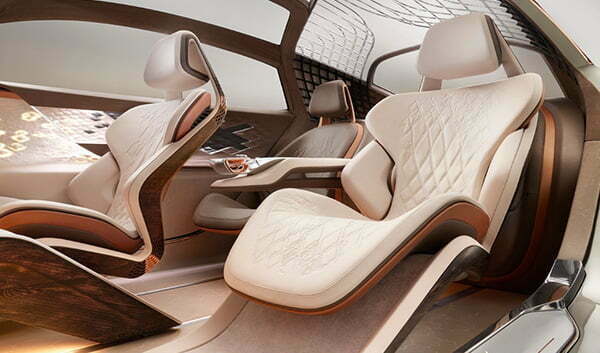This website uses cookies so that we can provide you with the best user experience possible. Cookie information is stored in your browser and performs functions such as recognising you when you return to our website and helping our team to understand which sections of the website you find most interesting and useful.

Luxury Cars Go Sustainable From the Inside Out
NY Times June 4, 2020
Under the hood is an electric motor, but can a car truly be green if the cabin is coated in leather and plastic?
As automakers push toward the electric future, recycled and sustainable materials — making the car lighter as well as greener — will line interiors.
These novel surfaces don’t just challenge the staid leather, wood and wool template that has dominated the category since the time of royal horse-drawn carriages. They conform to the industry’s, and customers’, interest in more environmentally friendly options. Luxury brands are leading the way.
Mercedes-Benz has incorporated a host of new materials. Dinamica, a sueded fabric made from recycled plastic bottles and clothing fibers, covers seats. Karuun, a compressed timber product made from sustainably harvested rattan, is used on floors and dashboard trim.
Bentley has experimented with Vegea, a vegan leather made from grape skins, seeds and stalks. The automaker has trimmed dashboards in veneers from lumber felled 5,300 years ago and preserved in bogs, a replacement for cutting down live trees.
And Polestar — Volvo’s new premium electric sub-brand — has used carpets made from recycled fishing nets. It has produced seat covers with 3-D knitting, a process that weaves just enough fabric, eliminating waste. And it has installed a flax-based composite from the Swiss supplier Bcomp to replace plastic in its dashboards and center consoles.

Most interesting, Polestar has created seat inserts made from a cork-based vinyl, in patterns inspired not by the tannery but by technical fabrics for camping and adventure gear.
“We have tried to create materials that are not emulating leather,” said Max Missoni, Polestar’s head of design.
ImageThe Precept from Polestar, a Volvo sub-brand, includes 3-D-knit fabric and plastics infused with cork product.
The Precept from Polestar, a Volvo sub-brand, includes 3-D-knit fabric and plastics infused with cork product.Credit…Volvo
This idea of creating a new design paradigm is crucial for manufacturers as they try to reinvent themselves for our battery-powered future — and for the tech-savvy early adopters they expect to make up their initial market.
“We are a new electric vehicle brand,” Mr. Missoni said. “So our mission really is to look at trends and societal changes, and derive a whole new aesthetics from those things.”
Many of these materials are also focused on saving weight, since lighter cars can travel farther on the same amount of electric charging.
“Our material can cut the weight of interior panels by up to 50 percent,” said Per Martensson, Bcomp’s chief sales officer. “So we reduce the plastic content drastically, and we increase the performance.”
In their quest for environmental friendliness, designers are also considering simpler sustainable materials. These include glass, ceramics, hemp and even paper.
“Perhaps you can elevate some of these materials in customer perception to still be worthy in a Bentley,” said Maria Mulder, Bentley’s head of color and trim.
It can take up to 10 years, and over $1 billion, to develop a single new car model, requiring huge production planning as well as a solid business strategy. This can push the automotive industry into more conservative choices. Designers therefore often look to more flexible industries for up-to-the-moment sustainability options.
“Fashion is fast living, but it gives an indication of what is possible if you dedicate a certain amount of time and development,” said Belinda Günther, Mercedes’s head of color and trim. “Furniture needs to survive for a number of years, so from a durability perspective, it’s interesting to see what is possible there.”
Both of these industries are exploring greener fabrics and procedures. “Sustainability is definitely a growing trend in the fashion industry,” said Rachel Cernansky, the sustainability editor for Vogue Business. “Whether it’s growing at the scale it needs to is another question.”
Ms. Cernansky pointed to the increasing use of “upcycled” polyester and nylon in high-end clothing, though she questioned whether these products were doing enough to stem our insatiable appetite for new objects.
“It’s problematic because it can’t be recycled again,” she said.
Ms. Cernansky is more compelled by companies like Tyton BioSciences and Natural Fiber Welding because they’ve created the capacity to turn fibers into fibers. This, she said, allows new fabric to be made from “the huge amount of clothing in the world that is not being worn, so we don’t need to harvest new resources.” But for now these companies are small, and scaling their tech will be costly.
Sustainable materials are also finding their way into high-end housewares and décor. “Clients, especially families, really like a lot of these recycled products because they wear well — they’re extremely durable,” said Young Huh, an interior designer in New York. “A lot of these solution-dyed recycled fabrics, because the dye is in the fiber, the colors don’t change, so you can bleach them.”
These characteristics are also useful in health and hospitality situations, like a Ronald McDonald House that Ms. Huh designed. Ronald McDonald Houses provide apartments for families near hospitals where their children are being treated, and the rooms previously had to be superheated after each stay to sterilize them. That can’t be done effectively with some natural fibers, but is possible with Xorel fabrics made from sugar cane by Carnegie Fabrics.
This quality could become even more relevant in the coronavirus pandemic. “You can wipe down vegan leather with sanitizer,” Ms. Huh said. “You can’t do that with leather.”
Long-term automotive manufacturing partners are beginning to adapt and work in conjunction with designers to identify and create more responsible options.
“We have traditional suppliers that are shifting toward sustainable materials because they’ve understood that there is a big trend in our industry toward that,” Mr. Missoni said. “And the more concepts that we show, the higher the pressure is to apply those materials in higher quantities, so that’s an important correlation.”
Mercedes is using a sueded fabric made from recycled materials, Dinamica, among others.Credit…Mercedes-Benz
Designers identified headliners, carpets, seat foam and door panels as key areas in which they’re exploring replacement materials. Already, Natural Fiber Welding is at work on a recycled vegan leather door panel for Porsche.
Designers say more significant transformations in automotive interiors to save weight and reduce plastics will take place by focusing on the materials onto which decorative elements are attached.
“We are looking into what we call the ‘underwear’ of the car,” said Ms. Günther at Mercedes. “To get a higher amount of recycled materials into the plastic carrier, or really go on to a natural carrier.”
Still, the most beneficial environmental change an automaker can enact is to produce more battery-powered vehicles.
“The materials and manufacturing burden of a new vehicle is only 6 percent to 25 percent of its lifetime carbon footprint,” said John Voelcker, a reporter and analyst on automotive sustainability. “All the rest is the energy used to move it around for the years it’s on the road.”
He added: “An electric car with interiors made out of anything short of baby panda skin is going to be way better for the planet than a gas-powered vehicle with an all-recycled interior.”


